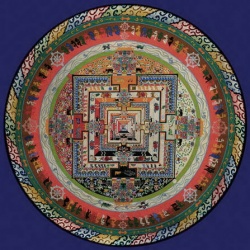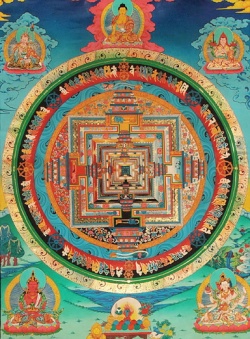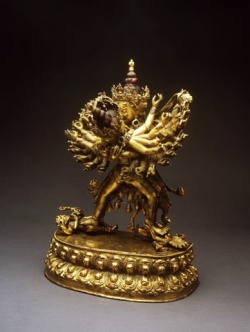Difference between revisions of "Explanation of the Kalachakra mandala"
| Line 1: | Line 1: | ||
[[File:Kal4kra_lg.jpg|thumb|250px|]][[File:Ka_i_tr52.jpg|thumb|250px|]][[File:L_pl1g19.jpg|thumb|left|250px|]] | [[File:Kal4kra_lg.jpg|thumb|250px|]][[File:Ka_i_tr52.jpg|thumb|250px|]][[File:L_pl1g19.jpg|thumb|left|250px|]] | ||
| + | |||
| + | |||
| + | |||
| + | |||
| + | |||
| + | |||
| + | |||
| + | |||
| + | |||
| + | |||
| + | |||
<poem> | <poem> | ||
| − | This version of the [[Kalachakra mandala]] was created by [[Losang]] [[Samten]] on January 29th March 8th, 2008 at Calfornia State {{Wiki|University}}, Chico. The [[Wheel of Time]] [[Mandala]], sometimes referred to as the [[Kalachakra Mandala]] is a [[vital]] part of the [[peace]] practices within the [[Dalai Lama's]] [[Namgyal Monastery]]. [[Losang]] [[Samten]] was trained within that setting and was given permission by [[His Holiness]] to create this [[sacred]] painting. | + | This version of the [[Kalachakra mandala]] was created by [[Losang]] [[Samten]] on January 29th March 8th, 2008 at Calfornia [[State]] {{Wiki|University}}, Chico. The [[Wheel of Time]] [[Mandala]], sometimes referred to as the [[Kalachakra Mandala]] is a [[vital]] part of the [[peace]] practices within the [[Dalai Lama's]] [[Namgyal Monastery]]. [[Losang]] [[Samten]] was trained within that setting and was given permission by [[His Holiness]] to create this [[sacred]] painting. |
Explanation of the [[Mandala]] | Explanation of the [[Mandala]] | ||
| Line 8: | Line 19: | ||
At the [[Dalai Lamas]] request in 1988 [[Losang]] [[Samten]] was sent to create the [[Kalachakra Mandala]] at the Museum of Natural History in NYC. This was the very first [[mandala]] created as a {{Wiki|cultural}} [[offering]] in the {{Wiki|Western}} [[world]], opening a great door for [[Tibet]]. | At the [[Dalai Lamas]] request in 1988 [[Losang]] [[Samten]] was sent to create the [[Kalachakra Mandala]] at the Museum of Natural History in NYC. This was the very first [[mandala]] created as a {{Wiki|cultural}} [[offering]] in the {{Wiki|Western}} [[world]], opening a great door for [[Tibet]]. | ||
| − | The [[Kalachakra]] takes everything into account: the [[body]] and the [[human]] [[mind]], and the whole external aspect. We firmly believe in its power to reduce conflict and we believe it is capable of creating [[peace]], [[peace]] of [[spirit]] and therefore [[peace]] in the [[world]]. The [[Dalai Lama]]- 2007 Recipient of the Congressional Medal of {{Wiki|Honor}} Sand Painting is [[traditionally]] from the [[monasteries]] of [[Tibet]], used during [[sacred]] [[rituals]] and inspired by the [[teaching]] of [[impermanence]]. The sand is blessed through [[chants]] and [[prayers]]. The sand painting [[master]], {{Wiki|adept}} in the [[wisdom of emptiness]], evokes the [[sense]] of great [[bliss]] and inner [[peace]] through [[meditation]]. This [[intention]] is [[essential]] to the construction process as every moment and {{Wiki|movement}} is performed as an [[offering]]. | + | The [[Kalachakra]] takes everything into account: the [[body]] and the [[human]] [[mind]], and the whole external aspect. We firmly believe in its power to reduce conflict and we believe it is capable of creating [[peace]], [[peace]] of [[spirit]] and therefore [[peace]] in the [[world]]. The [[Dalai Lama]]- 2007 Recipient of the Congressional Medal of {{Wiki|Honor}} Sand Painting is [[traditionally]] from the [[monasteries]] of [[Tibet]], used during [[sacred]] [[rituals]] and inspired by the [[teaching]] of [[impermanence]]. The sand is blessed through [[chants]] and [[prayers]]. The sand painting [[master]], {{Wiki|adept}} in the [[wisdom of emptiness]], evokes the [[sense]] of great [[bliss]] and inner [[peace]] through [[meditation]]. This [[intention]] is [[essential]] to the construction process as every [[moment]] and {{Wiki|movement}} is performed as an [[offering]]. |
n the [[tradition]] of the [[Namgyal Monastery]], [[Losang]] creates this artwork using the long narrow metal funnels called chakpu. The {{Wiki|movement}} of one chakpu against the other [[causes]] the sand to flow, creating a [[meditative]] [[sound]]. For the [[Buddhist practitioner]] this [[sound]] suggests the approach of higher [[consciousness]], the [[teaching]] of [[interdependence]] and [[emptiness]]. The presence of both chakpu is necessary for this {{Wiki|purpose}}; one [[symbolizing]] [[wisdom]], the other [[compassion]]; a recurrent theme in [[Buddhism]]. | n the [[tradition]] of the [[Namgyal Monastery]], [[Losang]] creates this artwork using the long narrow metal funnels called chakpu. The {{Wiki|movement}} of one chakpu against the other [[causes]] the sand to flow, creating a [[meditative]] [[sound]]. For the [[Buddhist practitioner]] this [[sound]] suggests the approach of higher [[consciousness]], the [[teaching]] of [[interdependence]] and [[emptiness]]. The presence of both chakpu is necessary for this {{Wiki|purpose}}; one [[symbolizing]] [[wisdom]], the other [[compassion]]; a recurrent theme in [[Buddhism]]. | ||
| − | The colored sand is then delicately applied into remarkable and richly [[symbolic]] patterns. The [[Kalachakra Mandala]], sometimes referred to as The [[Wheel of Time]], is one of [[Tibetan]] [[Buddhisms]] most complex works of [[sacred]] [[art]]. This virtual floor plan for a multi-leveled palace houses five separate yet {{Wiki|interrelated}} [[mandalas]]. Each has its own {{Wiki|purpose}} to {{Wiki|purify}} [[body]], [[speech]], [[mind]], and then [[consciousness]], culminating in the [[Wikipedia:Absolute (philosophy)|ultimate]] tier of Great [[Bliss]]. | + | The colored sand is then delicately applied into remarkable and richly [[symbolic]] patterns. The [[Kalachakra Mandala]], sometimes referred to as The [[Wheel of Time]], is one of [[Tibetan]] [[Buddhisms]] most complex works of [[sacred]] [[art]]. This virtual floor plan for a multi-leveled palace houses five separate yet {{Wiki|interrelated}} [[mandalas]]. Each has its [[own]] {{Wiki|purpose}} to {{Wiki|purify}} [[body]], [[speech]], [[mind]], and then [[consciousness]], culminating in the [[Wikipedia:Absolute (philosophy)|ultimate]] tier of Great [[Bliss]]. |
| − | Within the center of this palace reside the [[deity]] [[Kalachakra]] and his [[consort]], [[Vishvamata]]. This [[sacred]] union and its {{Wiki|representations}} are seen everywhere throughout this particular [[mandala]] as repeated affirmations of [[wholeness]] and completion.. {{Wiki|Sun}} and [[moon]], {{Wiki|feminine}} and {{Wiki|masculine}} as well as [[pristine awareness]] with [[transcendental]] [[knowledge]], all have fully merged. Also residing in this palace are 722 [[manifestations]] of the [[Kalachakra]] [[deity]]. These serve to bless the 722 [[chakras]] and channels of the initiate and viewer. The journey of the [[practitioner]] through this [[visual]] [[scripture]] is said to trace the progression toward the state of [[Awakening]] and Inner [[Peace]]. | + | Within the center of this palace reside the [[deity]] [[Kalachakra]] and his [[consort]], [[Vishvamata]]. This [[sacred]] union and its {{Wiki|representations}} are seen everywhere throughout this particular [[mandala]] as repeated affirmations of [[wholeness]] and completion.. {{Wiki|Sun}} and [[moon]], {{Wiki|feminine}} and {{Wiki|masculine}} as well as [[pristine awareness]] with [[transcendental]] [[knowledge]], all have fully merged. Also residing in this palace are 722 [[manifestations]] of the [[Kalachakra]] [[deity]]. These serve to bless the 722 [[chakras]] and [[channels]] of the [[initiate]] and viewer. The journey of the [[practitioner]] through this [[visual]] [[scripture]] is said to trace the progression toward the [[state]] of [[Awakening]] and Inner [[Peace]]. |
Surrounding the palace and its grounds are the [[protective]] forces of the [[5 Elements]]: [[Earth]], [[Water]], [[Fire]], [[Wind]] and [[Space]]. The outermost circle of the [[mandala]] represents the holding {{Wiki|environment}} for all that that takes place within its embrace. [[Compassion]] and [[Wisdom]] have united and [[loving-kindness]] prevails in this [[cosmic]] setting. | Surrounding the palace and its grounds are the [[protective]] forces of the [[5 Elements]]: [[Earth]], [[Water]], [[Fire]], [[Wind]] and [[Space]]. The outermost circle of the [[mandala]] represents the holding {{Wiki|environment}} for all that that takes place within its embrace. [[Compassion]] and [[Wisdom]] have united and [[loving-kindness]] prevails in this [[cosmic]] setting. | ||
Latest revision as of 13:10, 5 September 2024
This version of the Kalachakra mandala was created by Losang Samten on January 29th March 8th, 2008 at Calfornia State University, Chico. The Wheel of Time Mandala, sometimes referred to as the Kalachakra Mandala is a vital part of the peace practices within the Dalai Lama's Namgyal Monastery. Losang Samten was trained within that setting and was given permission by His Holiness to create this sacred painting.
Explanation of the Mandala
Mandalas, which have been around for millennium, speak to the depths within us that yearn to experience greater happiness and freedom. As circular representations of spiritual truths, they are intended to impart peace and healing to all beings as well as to the planet.
At the Dalai Lamas request in 1988 Losang Samten was sent to create the Kalachakra Mandala at the Museum of Natural History in NYC. This was the very first mandala created as a cultural offering in the Western world, opening a great door for Tibet.
The Kalachakra takes everything into account: the body and the human mind, and the whole external aspect. We firmly believe in its power to reduce conflict and we believe it is capable of creating peace, peace of spirit and therefore peace in the world. The Dalai Lama- 2007 Recipient of the Congressional Medal of Honor Sand Painting is traditionally from the monasteries of Tibet, used during sacred rituals and inspired by the teaching of impermanence. The sand is blessed through chants and prayers. The sand painting master, adept in the wisdom of emptiness, evokes the sense of great bliss and inner peace through meditation. This intention is essential to the construction process as every moment and movement is performed as an offering.
n the tradition of the Namgyal Monastery, Losang creates this artwork using the long narrow metal funnels called chakpu. The movement of one chakpu against the other causes the sand to flow, creating a meditative sound. For the Buddhist practitioner this sound suggests the approach of higher consciousness, the teaching of interdependence and emptiness. The presence of both chakpu is necessary for this purpose; one symbolizing wisdom, the other compassion; a recurrent theme in Buddhism.
The colored sand is then delicately applied into remarkable and richly symbolic patterns. The Kalachakra Mandala, sometimes referred to as The Wheel of Time, is one of Tibetan Buddhisms most complex works of sacred art. This virtual floor plan for a multi-leveled palace houses five separate yet interrelated mandalas. Each has its own purpose to purify body, speech, mind, and then consciousness, culminating in the ultimate tier of Great Bliss.
Within the center of this palace reside the deity Kalachakra and his consort, Vishvamata. This sacred union and its representations are seen everywhere throughout this particular mandala as repeated affirmations of wholeness and completion.. Sun and moon, feminine and masculine as well as pristine awareness with transcendental knowledge, all have fully merged. Also residing in this palace are 722 manifestations of the Kalachakra deity. These serve to bless the 722 chakras and channels of the initiate and viewer. The journey of the practitioner through this visual scripture is said to trace the progression toward the state of Awakening and Inner Peace.
Surrounding the palace and its grounds are the protective forces of the 5 Elements: Earth, Water, Fire, Wind and Space. The outermost circle of the mandala represents the holding environment for all that that takes place within its embrace. Compassion and Wisdom have united and loving-kindness prevails in this cosmic setting.
A Dismantling Ceremony is held at the completion of this beautiful creation. The participants are then invited to help brush the sacred sand into the center of the mandala, which is a profound affirmation of the impermanence of all things. Each person is invited to take a small amount of the sand and the remainder is ritually poured into a nearby body of water as a great blessing.


